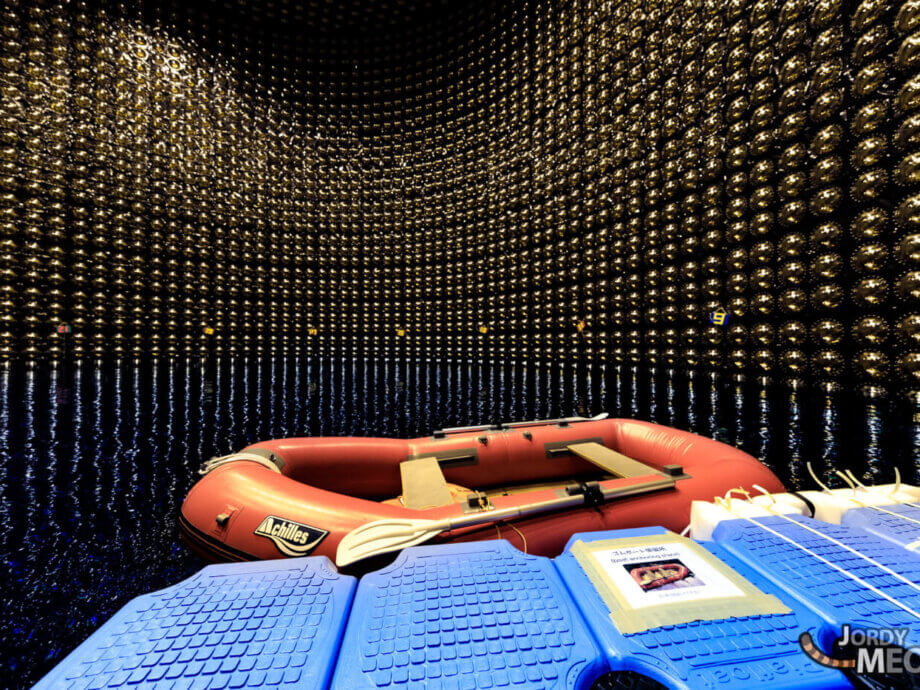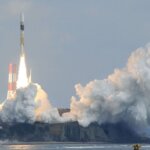Unveiling Hyper-Kamiokande: A New Era in Neutrino Science
Deep beneath the mountains of Hida, Gifu Prefecture, Japan, a monumental scientific endeavor is taking shape. The Hyper-Kamiokande neutrino observatory, poised to become the world’s largest and most sensitive detector of its kind, recently opened its vast underground cavern to the press for the first time. This milestone marks a significant step toward unraveling some of the universe’s most profound mysteries, from the origins of matter to the fate of the cosmos itself.
- Unveiling Hyper-Kamiokande: A New Era in Neutrino Science
- What Are Neutrinos and Why Do They Matter?
- The Hyper-Kamiokande Project: Ambition on a Grand Scale
- How Does Hyper-Kamiokande Detect Neutrinos?
- Scientific Goals: Probing the Universe’s Deepest Secrets
- International Collaboration and Technological Innovation
- Japan’s Legacy in Neutrino Research
- Global Competition and Complementary Experiments
- Looking Ahead: The Promise of Hyper-Kamiokande
- In Summary
Scheduled to begin observations in 2027–2028, Hyper-Kamiokande (often abbreviated as Hyper-K or HK) is the successor to the renowned Super-Kamiokande detector. With a cavern measuring 94 meters high and 69 meters in diameter, and a planned tank holding 260,000 tons of ultra-pure water, Hyper-Kamiokande will dwarf its predecessors and dramatically expand the frontiers of particle physics and astrophysics.
What Are Neutrinos and Why Do They Matter?
Neutrinos are among the most abundant yet elusive particles in the universe. Sometimes called “ghost particles,” they have no electric charge, are incredibly small—about 100,000 times lighter than an electron—and interact so weakly with matter that trillions pass through your body every second without leaving a trace. Despite their abundance, neutrinos are notoriously difficult to detect, requiring massive, sensitive detectors shielded from cosmic rays and other background noise.
Understanding neutrinos is crucial because they hold clues to some of the biggest questions in physics. Their properties may help explain why the universe is made mostly of matter rather than antimatter, how stars explode in supernovae, and whether protons—the building blocks of atoms—are truly stable or can decay over unimaginable timescales.
The Hyper-Kamiokande Project: Ambition on a Grand Scale
Hyper-Kamiokande is being constructed 600 meters underground in the Kamioka area of Hida City, Gifu Prefecture. The site was chosen for its stable rock, existing mining infrastructure, and the natural shielding provided by the mountain above, which filters out cosmic rays and other interfering particles. The main detector will be a gigantic cylindrical tank, 71 meters high and 68 meters in diameter, lined with over 20,000 ultra-sensitive photomultiplier tubes (PMTs) designed to capture the faint flashes of Cherenkov light produced when a neutrino interacts with water molecules.
This scale is unprecedented: Hyper-Kamiokande will contain about eight times the volume of water used in Super-Kamiokande, enabling it to observe far more neutrino interactions with much greater precision. The project is led by the University of Tokyo’s Institute for Cosmic Ray Research (ICRR) in collaboration with the High Energy Accelerator Research Organization (KEK) and more than 100 institutions from over 20 countries, making it a truly global scientific effort.
Construction Milestones and Challenges
Excavation of the main cavern began in 2021, following years of planning, geological surveys, and international collaboration. The access tunnel, stretching 2 kilometers into the mountain, was completed in early 2022, and the main cavern’s dome section was finished in late 2023. The barrel section, which forms the bulk of the detector’s volume, is being excavated in stages, with completion expected in 2024. Rising material costs and engineering challenges have pushed the start of observations from the original 2027 target to 2028, but the project remains on track for its ambitious goals.
Professor Masato Shiozawa of the ICRR, a leading figure in the project, expressed optimism at the recent unveiling:
“We aim to produce results that will fundamentally change our understanding of elementary particles.”
Once the cavern is complete, engineers will install the tank, line it with photodetectors, and fill it with ultra-pure water. The entire facility is designed to minimize background noise and maximize sensitivity to the rare and subtle signals produced by neutrino interactions.
How Does Hyper-Kamiokande Detect Neutrinos?
Neutrino detection relies on a phenomenon called Cherenkov radiation. When a neutrino occasionally collides with an electron or nucleus in the water, it can produce a charged particle that moves faster than the speed of light in water (though not faster than light in a vacuum). This creates a faint, cone-shaped flash of blue light—Cherenkov radiation—which can be detected by the photomultiplier tubes lining the tank.
By analyzing the timing and pattern of these flashes, scientists can reconstruct the energy, direction, and type (or “flavor”) of the incoming neutrino. Hyper-Kamiokande’s enormous size and advanced sensors will allow it to detect neutrinos from a wide range of sources, including:
- Neutrinos produced by cosmic rays striking Earth’s atmosphere
- Solar neutrinos generated in the heart of the Sun
- Neutrinos from distant supernovae and other cosmic events
- Artificial neutrino beams produced at the J-PARC accelerator, 295 kilometers away in Tokai, Ibaraki Prefecture
Scientific Goals: Probing the Universe’s Deepest Secrets
Hyper-Kamiokande is designed to tackle some of the most fundamental questions in physics and cosmology. Its main scientific objectives include:
1. Investigating Neutrino Oscillations and CP Violation
Neutrinos come in three types—electron, muon, and tau—and can change from one type to another as they travel, a phenomenon known as neutrino oscillation. This discovery, made at Super-Kamiokande in 1998, proved that neutrinos have mass and earned the 2015 Nobel Prize in Physics.
One of Hyper-Kamiokande’s top priorities is to study whether neutrinos and their antimatter counterparts (antineutrinos) oscillate differently—a difference known as charge-parity (CP) violation. If confirmed, CP violation in neutrinos could help explain why the universe contains more matter than antimatter, a mystery at the heart of cosmology.
By comparing neutrino and antineutrino beams sent from J-PARC and measuring their oscillations with unprecedented precision, Hyper-Kamiokande aims to provide a definitive answer to this question. After a decade of data collection, the experiment is expected to achieve a “gold standard” 5-sigma measurement for CP violation over a significant range of possible values.
2. Searching for Proton Decay: Testing Grand Unified Theories
Proton decay is a hypothetical process predicted by many theories that seek to unify the fundamental forces of nature. If protons can decay, it would mean that matter is ultimately unstable over extremely long timescales—far longer than the age of the universe. Detecting proton decay would revolutionize our understanding of physics and could point the way to a “Theory of Everything.”
Hyper-Kamiokande’s vast volume and sensitive detectors make it the world’s best laboratory for searching for proton decay. Even if no decay is observed, the experiment will set new lower limits on the proton’s lifetime, constraining or ruling out many theoretical models.
3. Observing Supernova and Relic Neutrinos
When a massive star explodes in a supernova, it releases a flood of neutrinos that can reach Earth before the light from the explosion. Hyper-Kamiokande will be able to detect tens of thousands of neutrinos from a supernova in our galaxy, providing a unique window into the processes that create heavy elements and shape the evolution of the cosmos.
In addition, the detector will search for the diffuse background of relic neutrinos from all past supernovae, offering insights into the history of star formation and the life cycle of matter in the universe.
4. Studying Solar, Atmospheric, and Geoneutrinos
Hyper-Kamiokande will continue the legacy of its predecessors by measuring solar neutrinos, probing the inner workings of the Sun, and testing models of stellar physics. It will also study atmospheric neutrinos to refine our understanding of neutrino oscillations and mass ordering.
Geoneutrinos—neutrinos produced by radioactive decay within the Earth—will help scientists investigate the planet’s internal structure and heat generation, with implications for geology and the geomagnetic field.
International Collaboration and Technological Innovation
The Hyper-Kamiokande project is a model of international scientific cooperation. More than 560 researchers from over 100 institutions in 21 countries are involved, including major contributions from Japan, the United Kingdom, Canada, Italy, Mexico, and others. The project’s budget, estimated at around $600 million, is primarily funded by the Japanese government, with significant support from international partners.
Technological advances are central to Hyper-Kamiokande’s capabilities. The new photomultiplier tubes, developed by Japanese company Hamamatsu and other partners, are more sensitive and reliable than previous generations. The water purification system, essential for reducing background noise, is among the most advanced in the world. Machine learning and artificial intelligence are being used to analyze the vast amounts of data generated, with institutions like Tecnológico de Monterrey in Mexico contributing expertise in software and data processing.
Japan’s Legacy in Neutrino Research
Japan has been at the forefront of neutrino science for decades. The original Kamiokande experiment in the 1980s made the first detection of solar neutrinos and observed neutrinos from supernova SN1987A, leading to the 2002 Nobel Prize for Masatoshi Koshiba. Super-Kamiokande, built in the 1990s, discovered neutrino oscillations and has been instrumental in advancing our understanding of these particles.
The T2K experiment, which sends a neutrino beam from J-PARC to Super-Kamiokande, has provided key measurements of neutrino properties and set the stage for Hyper-Kamiokande’s next-generation research. The new observatory will build on this legacy, pushing the boundaries of knowledge and inspiring future generations of scientists.
Global Competition and Complementary Experiments
Hyper-Kamiokande is part of a global race to unlock the secrets of neutrinos. Other major projects include the Deep Underground Neutrino Experiment (DUNE) in the United States, which uses liquid argon technology, and the Jiangmen Underground Neutrino Observatory (JUNO) in China. Each experiment has unique strengths and approaches, and their results will complement each other, providing cross-checks and a more complete picture of the neutrino world.
As Takaaki Kajita, Nobel laureate and a leader in the field, has noted, the complementarity of these experiments is crucial for robust scientific progress. Hyper-Kamiokande’s proven water Cherenkov technology, combined with its unprecedented scale, gives it a leading edge in sensitivity and versatility.
Looking Ahead: The Promise of Hyper-Kamiokande
With excavation nearing completion and installation of the detector components set to begin soon, anticipation is building in the scientific community. The first data from Hyper-Kamiokande could arrive as early as 2027–2028, ushering in a new era of discovery.
Director Shiozawa Masato of the ICRR summed up the excitement and ambition of the project:
“I hope to see research outcomes that would surprise everyone, so I urge people to keep up to date on the project.”
Whether it’s revealing the secrets of neutrino oscillations, catching the first glimpse of proton decay, or providing early warnings of supernovae, Hyper-Kamiokande stands at the threshold of transformative science. Its discoveries may reshape our understanding of the universe and our place within it.
In Summary
- Hyper-Kamiokande is set to become the world’s largest and most sensitive neutrino observatory, located 600 meters underground in Hida, Gifu Prefecture, Japan.
- The project aims to answer fundamental questions about the universe, including the origin of matter, the stability of protons, and the behavior of neutrinos.
- Construction of the main cavern is nearly complete, with installation of the detector and first observations expected by 2027–2028.
- Hyper-Kamiokande will use a massive tank of ultra-pure water and tens of thousands of photomultiplier tubes to detect faint flashes of light from neutrino interactions.
- The experiment is a global collaboration involving over 100 institutions from more than 20 countries, with significant technological and scientific innovation.
- Japan’s leadership in neutrino research, recognized by two Nobel Prizes, continues with Hyper-Kamiokande, which will complement other major international experiments.
- The scientific community anticipates groundbreaking discoveries that could fundamentally change our understanding of physics and the universe.












